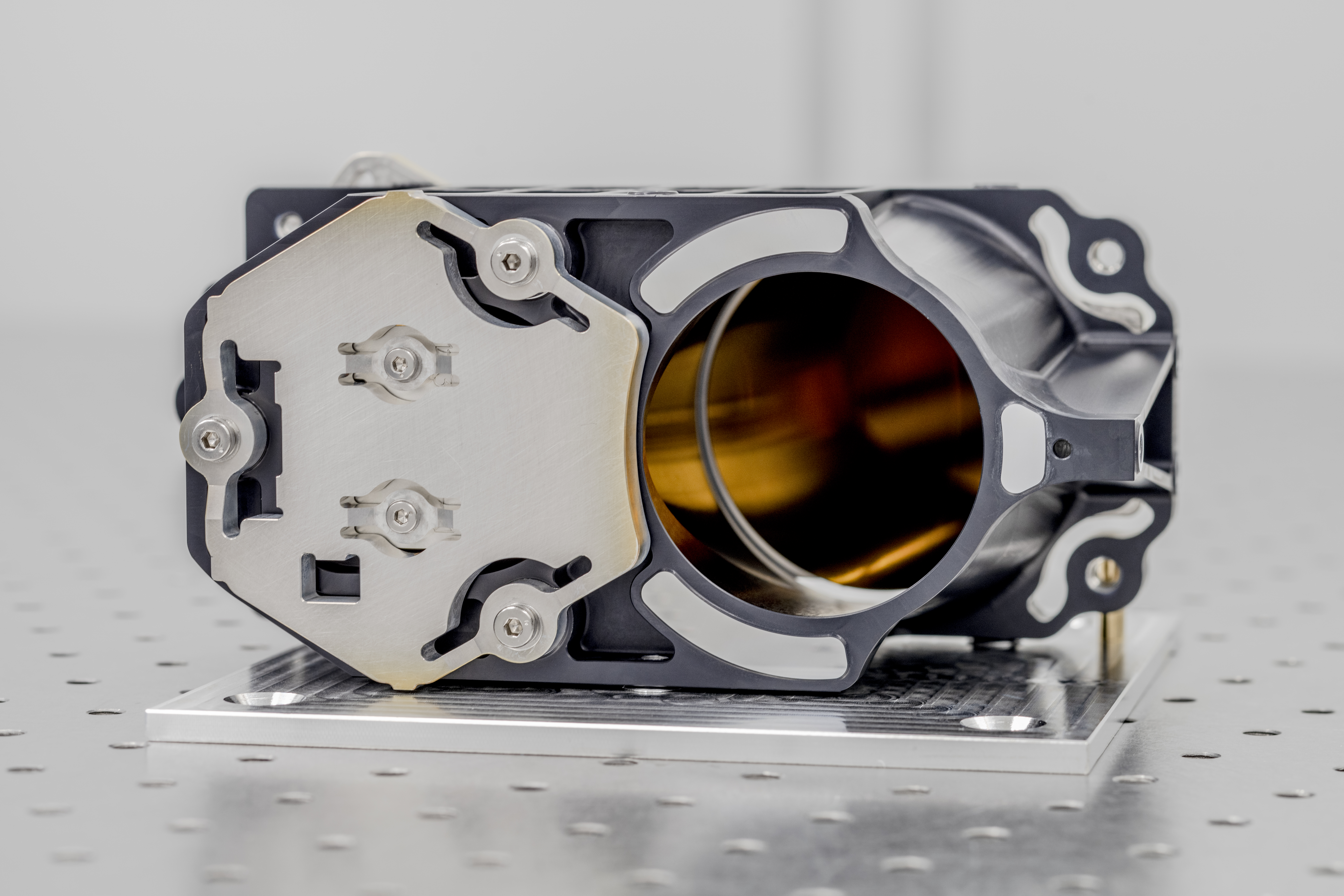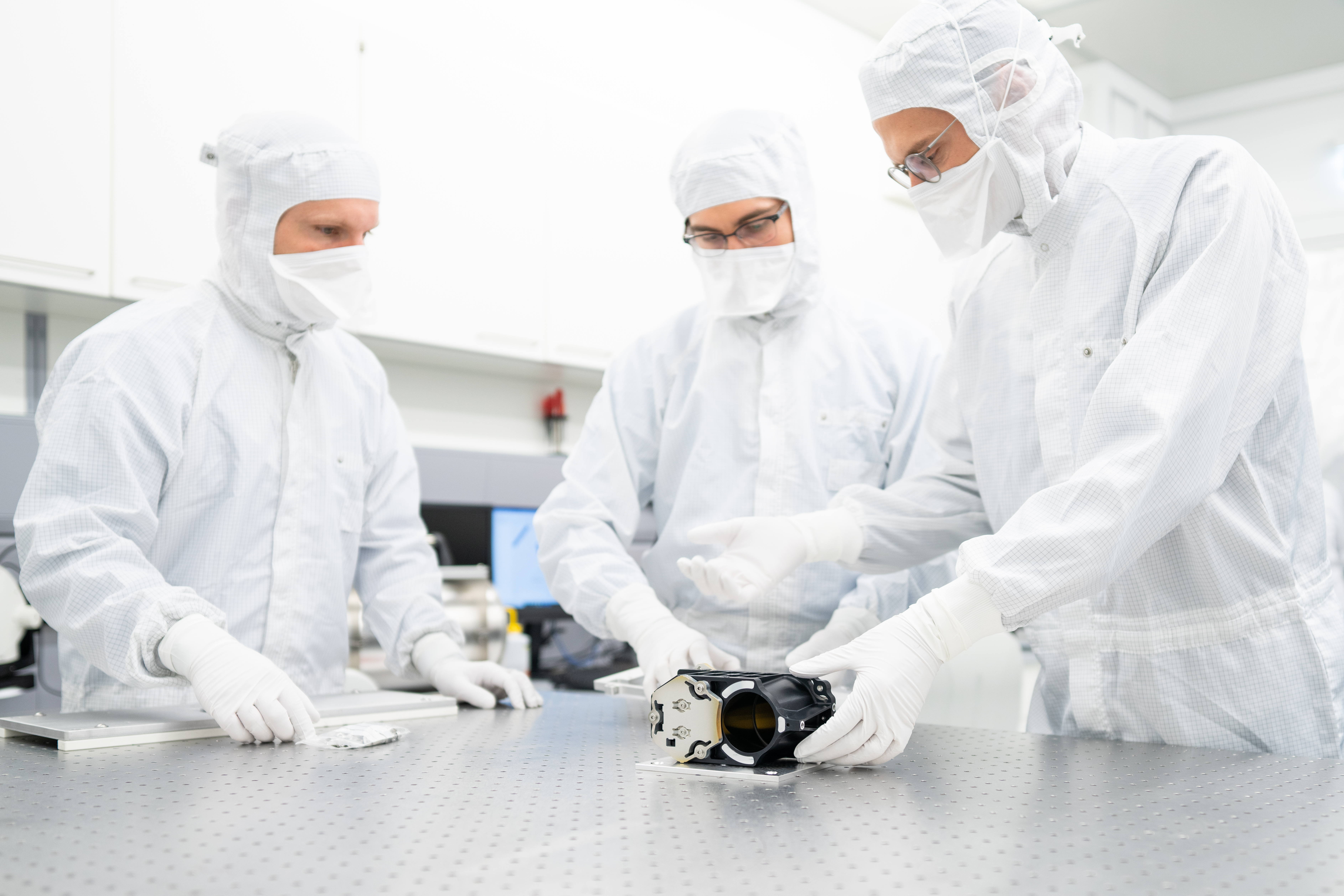Measuring instrument will enable more efficient use of water in agriculture in the future
New mirror telescope for Earth observation ready for flight to the International Space Station ISS
Researchers from Jena and Freiburg have jointly developed a new type of mirror telescope for use on the International Space Station ISS. The findings that the measuring instrument will provide there in the future should, among other things, provide answers to climate change and facilitate the efficient use of water in agriculture. The instrument will begin its journey into space in February 2022. The development of the telescope was funded by the “Digital Innovation Hub Photonics,” a Thuringian initiative to promote start-up projects in the fields of optics and photonics.
Climate change poses huge challenges for us. One of them is dealing with the resource water. In order to enable a more efficient management of resources in the future, especially in agriculture, the Fraunhofer Institute for Applied Optics and Precision Engineering IOF in Jena and the Fraunhofer Institute for High-Speed Dynamics, Ernst-Mach-Institut, EMI, in Freiburg, have teamed up with the companies SPACEOPTIX and ConstellR - both spin-offs from the Fraunhofer-Gesellschaft - to develop a novel mirror telescope. The telescope is part of a measuring instrument that will measure the planet's water cycle from the International Space Station ISS. A thermal infrared camera will be used to measure the land surface temperature of our planet. The measuring instrument is a forerunner of a constellation of so-called microsatellites that will provide even more comprehensive data in the near future.
New satellite images provide answers to climate change

Satellite images already play a major role in gathering information about our planet's ecosphere – and their importance continues to grow. These data, obtained from space, provide information about its geology, weather phenomena, and agricultural production cycles, for example. New, meaningful and diverse data from Earth observation are now indispensable for making early and reliable predictions about crop yields, for example, due to the difficult-to-predict effects of climate change.
To obtain such up-to-date and accurate information with high spatial resolution and temporal coverage, global and local data will therefore be obtained in the near future by swarms of satellites, so-called satellite constellations. The size of a satellite constellation ranges from ten to several hundred identical satellites.
For cost-effective realization of these constellations, a swarm will consist of very small satellites, so-called microsatellites about the size of a shoebox. These are powerful and resilient thanks to the ongoing miniaturization of the necessary technology.
Close cooperation between Fraunhofer Institutes and their spin-offs

With the realization of a satellite constellation in the thermal infrared spectrum, the start-up ConstellR GmbH, which is based in Freiburg and a spin-off of Fraunhofer EMI, has set itself the goal of closing a relevant gap in Earth observation: “In this spectral range, surface temperature can be measured very precisely as a key variable in the description of our environment,” explains Marius Bierdel, CTO of ConstellR GmbH. “This knowledge can be used, for example, to monitor the water requirements of crops in agriculture and use it to predict accurate crop yields.”
Funded by the German Federal Ministry for Economic Affairs and Energy, the first step on the way to the planned constellation, ConstellR technology will be deployed on the International Space Station ISS in spring 2022. Among other things, the optical part of the measuring instrument, consisting of a metal telescope with freeform mirrors, will be demonstrated during the mission. The telescope was realized in cooperation between the Fraunhofer Institutes EMI and IOF and their spin-offs ConstellR GmbH and SPACEOPTIX GmbH.
The design of the opto-mechanical telescope was developed at Fraunhofer IOF. “The institute has a wealth of experience in the development of high-performance optics for use in space,” says Dr. Matthias Beier, CEO of SPACEOPTIX GmbH. “The production of the mirrors, the telescope structure as well as the mechanical structural components of the opto-mechanical total payload took place in our own manufacturing facilities. As a spin-off of Fraunhofer IOF, we specialize in the series production of metal optics for space applications.”
The project for developing the telescope was funded by the pilot project “Digital Innovation Hub Photonics” (DIHP), an initiative supported by the Free State of Thuringia to promote start-up projects in the fields of optics and photonics. The head of DIHP, Dr. Sebastian Händschke, says: “This cooperation and the presented result are a very good example of the intention of DIHP and teaming up with spin-offs.” The two start-ups ConstellR and SPACEOPTIX had each won 50,000 euros in research funding at DIHP's second Elevator Pitch in January 2020, which has now been used to develop the free-form mirror telescope at Fraunhofer IOF.
From Jena to Freiburg to Texas - continuing into space
Following the successful integration and optical characterization, the telescope was handed over to Fraunhofer EMI and the company ConstellR in Jena in September 2021.
After transporting the telescope to Freiburg, electronic components as well as a detector will now be assembled, and the entire measuring instrument will undergo tests. The instrument is scheduled to be transported to the launch site in Houston, Texas, USA, in November 2021, before flying to the International Space Station ISS on flight NG-17 on February 19, 2022.